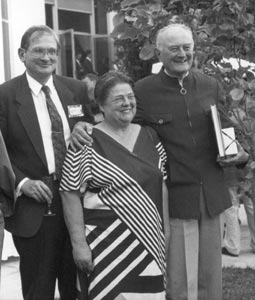Hagedorn’s Legacy
A half-day workshop took place last week at CERN on Hagedorn’s Legacy. It provided the forum for discussing the past, present and future of Hagedorn’s contributions to physics, 50 year’s after the publication of his seminal Nuovo Cimento paper on the “Statistical thermodynamics of strong interactions at high energies”.
Fifty years have passed since Rolf Hagedorn published his influential paper “Statistical thermodynamics of strong interactions at high-energies” (1965), in which he applied thermodynamics in the field of particle production and strong interaction physics. One of his most interesting ideas was what we now call the Hagedorn temperature. He showed that when collision energy is increased causing new particles to be produced, the entropy of a system increases, but the temperature becomes stuck at a limiting value. In a nutshell, once hadronic matter reaches this temperature, it must convert into quark matter or evaporate. To put it simply, it can be considered the “boiling point” for hadronic matter. Although Hagedorn met many objections, even within the CERN Theory Division, where he worked, he insisted on his theory, solving the problems that appeared one after the other. His particle-production models turned out to be remarkably accurate at predicting yields for the many different types of secondaries that originate in high-energy collisions.
Rolf Hagedorn had an unusually diverse background, having studied thermal, solid-state, particle and nuclear physics. He first came into contact with mathematics in a prison camp during WWII and after the war ended he attended the University of Göttingen, continuing his studies at the Max Planck Institute for Physics, where he met Heisenberg. He arrived at CERN in 1954 to work in particle accelerators and later joined the Theory Division, remaining there until his retirement.

In the past fifty years, our understanding of particle production and hadron phenomena has changed significantly thanks to Hagedorn's influential work. His 1965 paper placed the maximum temperature in the vocabulary of particle physics and has become one of the most cited physics papers. Although initially the concept was simply used to refer to the maximum temperature in hadron collisions, today, it describes the phase boundary between hadron and quark matter. It has even found its way into string theory to indicate the transition at which very long strings are produced. According to some string theory models, the Hagedorn temperature is 1030 K. As any great idea, Haedorn's work has grown in significance over the decades, providing new ways of exploring the world and inspiring future generations of scientists.
